Blakeslee and the Mustang
“I’m going to fly the ass off each one of you”, said Col Don Blakeslee when he took command of the Debden based 4th Fighter Group — it illustrated his hard-bitten approach to aerial combat.

Colonel Don Blakeslee in the cockpit of his P-51D Mustang WD-C at Debden
It’s 2 July 1944 and a lone P-51B Mustang is duelling single-handed with twelve Messerschmitt Bf109Gs from Jagdgeschwader (JG) 27 at 18,000 feet over Budapest. In the Mustang’s cockpit the pilot is pulling back on the control stick as hard as he dares as he reefs his plane into a firing position on the Bf109G in front of him while trying to outturn the Bf109G gaining on his tail. The odds seem impossible but this pilot is Colonel Don Blakeslee, commanding officer of the US 8th Air Force’s 4th Fighter Group (FG), a man who has been fighting the air war since 1941 and who is an evangelical exponent of the virtues of the P-51.
Described by the RAF’s top scoring fighter pilot, James ‘Johnnie’ Johnson as, ‘One of the best leaders ever to fight over Germany,’ Blakeslee was determined to make his group the top-scoring outfit in the 8th Air Force. In the North American P-51 Mustang, Blakeslee had found the tool to make this happen.

North American P-51D Mustang G-CMDK 44-73877 in the capable hands of Alistair 'Steg' Williams during an air to air photo sortie for this article. The Mustang was painted in Colonel Don Blakeslee's colours in 2020.
Born in Fairport Harbor, Ohio on 11 September 1917, Donald James Matthew Blakeslee became hooked on aeroplanes as a teenager when visiting the annual National Air Races held 30 miles away in Cleveland. Joining the U.S. infantry reserves in 1938, Blakeslee and a friend saved their wages and bought a Piper J-3 Cub which they loaned to a local flying school in return for instruction allowing Blakeslee to gain his pilot’s license. As the phoney war in Europe turned to Blitzkrieg, the Piper Cub was traded in for a three seat Waco biplane but within two weeks, on 3 June 1940, tragedy struck as the Waco crashed killing the pilot, one of Blakeslee’s close friends. With no aircraft and an escalating war on the other side of the Atlantic, Blakeslee turned his attention to the Royal Canadian Air Force (RCAF), resigning his commission in the infantry and travelling to Canada under a promise to his mother that he would stay an instructor and not be involved in combat.
Trained at Camp Borden, Ontario, Blakeslee gained his wings in March 1941 before heading to England and 57 Operational Training Unit at RAF Hawarden where he learned to fly and fight in the Supermarine Spitfire. The course finished at the end of June 1941 and Blakeslee was posted to the newly formed No 411 Squadron (RCAF) at RAF Digby, before moving to the Spitfire V equipped 401 Squadron (RCAF) at the end of October. On 18 November, Blakeslee made his first claim, a Bf109F damaged on a fighter sweep near Le Touquet in France, and within four days had scored his first victory, a Bf109E shot down south of Marck.

Pilot Officer Don Blakeslee is seen climbing into his Spitfire Mk V while serving with 401 "Canadian" Squadron in the Spring of 1942. Blakeslee's soon to be wife's name, Leola, is printed under the windscreen.
In constant combat, Blakeslee continued to inflict damage on the Luftwaffe over the winter and into the spring of 1942. In May, Blakeslee made his final move in the RAF to the newly reformed 133 Squadron, one of three ‘Eagle’ squadrons manned by US volunteers, flying his first mission on 3 June. In August he was awarded the Distinguished Flying Cross, the first of many decorations that he would receive during the war. Over two days, including the infamous commando raid on Dieppe, he shot down a Do217 and an Fw190A, probably destroyed another Fw190A and damaged a further two.

2nd Lt. 'Steve' Pisanos, and Capts. Don Blakeslee and Vernon Boehle pose in front of a Spitfire Mk Vb in late 1942.
The Eagle squadrons transferred to the USAAF in September 1942 where they became the founding units of the 4th FG. In November, Blakeslee became the commanding officer of the group’s 335 Fighter Squadron (FS) and in March 1943, the group re-equipped with the pugnacious Republic P-47 Thunderbolt, Blakeslee famously being heard to comment that these, ‘Seven-ton monsters seemed very reluctant to leave the ground and very anxious to get back on it.’ Despite this impression, Blakeslee shot down three Fw190s in the Thunderbolt, including his fifth confirmed victory which made him an ace. He was also badly shot up twice, the big fighter proving its worth by bringing him home both times. However, Blakeslee was never a fan of the Republic fighter.

On 16 August 1943, Lt. Col. Blakeslee's P-47 Thunderbolt WD-C, Serial No. 42-7863, was shot up by three Focke-Wulf Fw-190s - he was safely escorted home by Lt. James Goodson. Note the huge oil stain obscuring much of the fuselage, cockpit and tailplane.
In May 1943, as the US fighter force found its feet, Blakeslee became the Group Executive Officer, being promoted to the rank of Lieutenant Colonel. His exceptional leadership skills were coming to the fore and he led the group on several missions such as on 16 August 1943 when the 4th provided escort to B-17s of the 1st Bomb Division attacking Le Bourget airfield near Paris. The bombers were already under attack from numerous Bf109Gs and Fw190As of JG2 when the P-47s arrived and Blakeslee led the Thunderbolts into the fray. Over the next hour, the 4th claimed 18 enemy fighters shot down for the loss of only one P-47, whose pilot evaded capture, while only four of the 171 bombers despatched failed to return from the mission from all causes. This was the worst loss suffered by the Luftwaffe to date, and for JG2 in particular it was the unit’s worst mauling in the whole of 1943 with nine pilots confirmed killed and 14 aircraft destroyed over the course of the days fighting.
Of the four 8th Air Force fighter groups involved that day, only the 4th made claims and this was entirely down to Blakeslee’s leadership in the air. Orbiting above the battle, Blakeslee directed his men to the enemy formations, managing to keep situational awareness and control of the squadrons even after combat had been joined and units had broken up into flights and sections. This ability was more colourfully described by Grover C. Hall, the group’s Public Relations Officer who said of Blakeslee’s talent, ‘He was everywhere in the battle, twisting and climbing, bellowing and blaspheming, warning and exhorting. His ability to keep things taped in a fight with 40 or 50 planes skinning and turning at 400 miles an hour was a source of wonder.’
Blakeslee’s skills had not gone unnoticed at VIII Fighter Command, and when the new, long-range P-51B Mustang escort fighter arrived in theatre, he was given the job of introducing the 354th FG’s pilots and planes to combat. The group’s first mission, a fighter sweep over the continent, was on 1 December 1943 and as Blakeslee briefed the assembled pilots on tactics, including an exhortation not to break away if going head to head with an enemy fighter, he was asked what would happen if the other pilot didn’t break either. Blakeslee replied in his typical style, ‘Son, you will have just earned your flight pay the hard way.’
Blakeslee flew six missions with the 354th, claiming a Bf109 in heavy combats during an escort to Bremen and Wilhelmshaven on his last mission on 20 December. Completely hooked on the new fighter, Blakeslee returned to Debden two days later, adamant that the 4th should be the next group to get Mustangs, a position given more weight by his imminent appointment as group commander, effective on 31 December. Despite some teething troubles, the Mustang had the range to accompany the bombers all the way to the target and, when there, the performance and agility to outfight the defending Luftwaffe fighters.

Colonel Don Blakeslee arrives at Debden piloting the first Mustang assigned to the 4th Fighter Group. It was later turned over to the 334th Fighter Squadron.
Using the group’s prior experience on the Merlin powered Spitfire as leverage, Blakeslee pleaded his case with Major General William E. Kepner, the head of VIII Fighter Command. Kepner relented, Blakeslee famously promising that he would have the group operational on Mustangs within 24 hours of switching from the P-47. At the time, the 355th FG had been slated as the first existing 8th Air Force group to re-equip and had already received some Mustangs for training. These were duly sent to Debden, Blakeslee flying the first P-51B into the Essex base on 13 February 1944.
At Debden, the group’s pilots began training on the new fighter while continuing to fly combat in their P-47s. More Mustangs arrived and on 25 February the group flew its last bomber escort with Thunderbolt, feverish activity at Debden following as the Mustangs were readied for the following days’ mission. Bad weather then set in and it was 28 February before the group was able to take its new charges on an operation for the first time, 22 P-51Bs being part of the escort for bombers attacking Noball targets in northern France. The group’s pilots had an average of just 40 minutes flying time in their aircraft.

By now, Blakeslee had one aim which he had made clear when taking command, stating that, ‘The Fourth Fighter Group is going to be the top Fighter Group in the Eighth Air Force. We are here to fight. To those who don’t believe me I would suggest transferring to another group. I’m going to fly the arse off each one of you. Those who keep up with me, good; those who don’t, I don’t want them anyway.’
As a person, the six feet tall, square-jawed and pale-blue eyed Blakeslee was tough-talking and suffered no fools, fellow 4th FG pilot Major James A. Goodson describing him as a man who was, ‘Rough and tough, often lost his temper, drank heavily and swore frequently.’ He was an imposing figure to newly posted pilots fresh out of training, especially when giving his welcome talk as described by Frank Speer who joined the group in April 1944. ‘The culmination of the routine was the welcome by our new (to us), awe-inspiring Group Commander, Col. Blakeslee. He made an imposing entrance in his leather flight jacket and forty-mission crush hat. He looked like he had just come back from a mission.’
Lieutenant ‘G.I.’ Gillette was posted to the 4th in May 1944 recalling, ‘I don’t remember much about his talk, except the last thing he said. “I’ll see you guys at the bar tonight. I don’t want anybody in my outfit that won’t drink, because a man who won’t drink won’t fight, and I don’t want any son-of-a-bitch in my outfit who won’t fight!” He waved his hand and walked out. That made an impression on me.’

Blakeslee’s no-nonsense, straight talking approach to fighting and leadership, alongside his hard drinking and high living behaviour on the ground, won the respect and devotion of the men who served under him. Unfortunately, this did not transfer as well to his relationship with his superiors and he often returned from headquarters strategy sessions in a foul mood. It also hindered his advancement in the Air Force, Blakeslee never attaining a rank higher than Colonel.

Colonel Don Blakeslee flew his assigned P-51B Mustang, Serial No. 43-6437 during the 4th Fighter Group's first mission to Berlin on 3 March 1944. In this photograph his wheels have just been chocked following his return from the historic mission.
Within a week of the 4th’s inaugural Mustang operation, Blakeslee led the fighter escort for the 8th Air Force’s first attempts to bomb targets in Berlin although bad weather severely hampered the missions. No bombers reached the city on the 3rd although P-38 Lightnings did, becoming the first 8th Air Force fighters to fly over the German capital. The next day, poor weather caused almost all of the bombers to abandon the mission apart from 30 B-17s of the 13th Combat Bomb Wing which hit the primary target, an industrial area in south west Berlin. Blakeslee led 28 Mustangs over the target area to escort them where the force was attacked by more than 20 Luftwaffe fighters. One Bf109 was claimed destroyed after the pilot bailed out and another probably destroyed in the ensuing combat. The next day the group escorted bombers against Luftwaffe airfields in France, Blakeslee claiming the destruction of an Me210.
6 March saw the weather clear enough for the 8th to make another attempt at Berlin, the 4th FG again being responsible for target support. The Luftwaffe reacted in force resulting in 69 heavy bombers being shot down by fighters and flak alongside 11 escort fighters, the 8th Air Force’s worst single mission loss of the entire war. Blakeslee led the group over the German capital and in the vicious dogfights that followed the 4th claimed 13 enemy aircraft destroyed for the loss of four Mustangs, three of the pilots surviving to become Prisoners of War (PoW).

3 March 1944 - Lt Col. Don Blakeslee hands his maps to crew chief S/Sgt Harry East before climbing out of his P-51B Mustang after the 4th Fighter Group's first Berlin escort mission. The mission was not a rousing success, for although the 4th FG destroyed eight enemy aircraft, four of its Mustangs failed to return to Debden.

The heavy fighting continued throughout the spring with no sign of let up. On 18 March, as the Mustangs took up escort duty near Augsburg, they saw a large gaggle of Luftwaffe fighters heading for the bombers and dove to intercept. Losing sight of the main formation, Blakeslee and his wingman, Captain Don Gentile, one of the group’s top scoring aces, bounced a formation of six Fw190s that had just made a pass on a box of bombers and were diving down on another box below. Seeing the Mustangs in pursuit, the Fw190s dove for the deck. Choosing one of the trailing Fw190s as his target, Blakeslee told Gentile to take the other but as Gentile closed, the German pilot flick-rolled and broke away. The Mustangs continued their dive, Gentile staying with Blakeslee to cover him and scoring hits on another Fw190 that was off to the right of Blakeslee’s P-51B. This was enough to cause the pilot to bail out as the fighters passed through 6,000 feet.
Blakeslee was still on the tail of two Fw190s but now another three pulled up into a climbing turn to the left and attempted to bounce the Mustangs from the other side. Gentile turned into them and fired causing them to break off and dive away. By now the chase had descended to tree top level as Blakeslee described in his encounter report, ‘When I finally closed to within 200 yards of the #3 A/C I saw strikes all along the tail, fuselage, cockpit and engine. The cockpit hood fell off and the engine started to smoke and burn and the left undercarriage fell down. I pulled up when 150 yards from the E/A and did not see him go in but Capt Gentile saw him hit the ground.’ Just as the Mustangs formed up they were bounced by two more Fw190s. A desperate turning fight followed with the American pilots gradually gaining the advantage. Seeing this, the Fw190s split-essed and dived down allowing Blakeslee and Gentile to disengage west at full throttle. The Fw190s followed for a few minutes before giving up leaving the two Americans to return to Debden to claim one Fw190 each destroyed.
During April, Blakeslee claimed three and one shared aerial victories. The first of these, a brace of Bf109s, was claimed on 22 April on an escort mission to Hamm, the group sweeping ahead of the bombers and spotting around 20 Bf109s circling below them at 4,000 feet. Leading the 335th FS and 336th FS down to bounce them, the 334th FS staying as high cover, the group found breaking into the Messerschmitt’s defensive lufberry difficult until two Bf109s broke away, opening up the circle. The hunt was now on with most of the enemy fighters trying to escape by diving.
Blakeslee, ‘I saw an Me109 with belly tank, headed N.E. up a shallow valley, just skimming the trees. I gave a short burst at 300 yards, then closed to 200 and gave him a second burst. I was closing fast indicating 350 mph when I saw his tank strike the ground. I was not more than 15 feet above him as I passed over him and I saw his prop churn into the ground, throwing pieces, and the aircraft then crashed violently.’

Colonel Don Blakeslee in the cockpit of his P-51B Mustang at Debden in April 1944
Blakeslee climbed back up to 5,000 feet where he sighted another Bf109 3,000 feet below with Mustangs on its tail. Blakeslee, ‘dumped flaps and dove. The E/A straightened out as I got to him and I fired a 2 second burst from 200 yards as he was pulling up over some trees. My fire hit the E/A on the wing roots and cockpit, and his prop and wing hit a tree top, cart wheeling him into the deck.’ Blakeslee’s two claims added to the 16 other victories claimed by the group for the loss of one P-51, Lieutenant Nelson bailing out to become a PoW.
Two days later, Blakeslee was again in command leading the group on a sweep to the Frankfurt area hunting for any Luftwaffe fighters attempting to form up to hit the bombers on their way to targets around Munich. A gaggle of 35 Fw190s was reported at 10,000 feet heading for the bomber track and Blakeslee led the group to intercept, climbing into the sun above and behind the Focke Wulfs. Leaving the 336th FS as top cover, the rest of the Mustangs dove down virtually line abreast and began to decimate the Luftwaffe formation in a series of swirling dogfights that ranged from 10,000 feet down to the deck.
Blakeslee; ‘I picked out an Fw190 3rd or 4th in from the port side of the gaggle and opened fire, obtaining strikes. The E/A broke hard left and up and then evaded to the deck. I started to give chase but had several others on my tail so I broke off and engaged another Fw190. We went around in tight circles and I got in a few bursts, when he headed to the south east I got on his tail, opening at 300 yards with a 2 second burst, finally closing to 150 yards. I was getting strikes on him, when I saw him jettison his hood and helmet. I overshot him, and as I did so, I saw him unfastening his straps and watched him jump at 600 feet. His chute opened just above the ground.’
Blakeslee then spotted another Fw190, obtaining strikes along the cockpit, but just as he was lining up to deliver the final blow, another P-51 cut in and finished the hapless fighter off, Blakeslee only able to claim one Fw190 damaged. In total, the group claimed 16 victories for the loss of three Mustangs, one pilot being killed and two becoming PoW.

By May 1944 Colonel Blakeslee was flying bare metal P-51B Mustang 42-106726 with his customary WD-C codes, the C standing for 'Chief cook and bottle washer.'
Blakeslee’s next aerial victory came on 29 May, the 8th and 15th Air Forces mounting a combined attack against oil and aviation related targets from their bases in England and Italy. The 4th flew as part of the escort for 1st Bomb Division B-17 Flying Fortresses hitting targets around Posen, Poland. As Blakeslee led the group past the first box of bombers, two Me410s made a head on pass on the B-17s getting hits on several as they flashed through the formation. Dropping tanks, Blakeslee led two sections of Mustangs in pursuit, both Me410s being downed in short order with Blakeslee claiming the second at tree top level, his fire causing it to ‘crash into the woods and set them afire.’ The group finished the mission with a strafing attack on 14 Dornier Do18 seaplanes moored at the Dievenow seaplane base, Blakeslee claiming damage to two of them.
With D-Day fast approaching, the groups of VIII Fighter Command were heavily involved with strafing and dive bombing missions in support of the invasion but soon a very special operation was to occupy the 4th. On 21 June, Blakeslee led a force of 49 Mustangs from the 4th FG and 16 from the 352nd FG from Debden to Piryatin, USSR, on the first shuttle bombing mission undertaken by the 8th Air Force, a feat that Blakeslee once said was the greatest achievement of his combat career.
Navigating through heavy weather across northern Europe, rendezvous with the bombers was made over Lezno, Poland as described by Lt. Don McKibben of the 486th FS, ‘At exactly the briefed minute, the red-nosed ships of the 4th Group and our own blue-nosed planes swung over the bombers and began weaving out to the side and over the glistening B-17s...There’s something dignified and majestic about a large formation of our bombers plodding through the sky, and knowing we were flying over territory never before visited by American aircraft, a certain pride was felt by all our boys.’
Blakeslee’s navigation had been spot on and the bombers headed east after successfully hitting their target, a synthetic oil plant at Ruhland, Germany. After an hour, the relative peace of the mission was broken by a force of 25 Bf109Gs from JG51 that rose to intercept the bombers near Siedlce, Poland. Unable to pursue the enemy fighters due to the need to conserve their fuel, the Mustangs nevertheless broke up the attack and claimed six destroyed and four damaged for the loss of one P-51. Testament to the skill of the escorts, no bombers were lost during the attack. Blakeslee still had a final, exacting task left, namely navigating the fighter force to its assigned airfield over 1400 plus miles from their home base. Blakeslee accomplished this with just a clutch of over 16 maps and his wrist watch, the Mustangs arriving over Piryatin on schedule at 1450 hours.
This was just the beginning of the adventure, as that night Luftwaffe bombers struck at the B-17s based at Poltava with flares being dropped above Piryatin which the Russian Anti-Aircraft gunners tried to shoot out, much to the consternation of the American pilots. The next day the Mustangs were dispersed to airfields further east and it was 26 June before the force departed for Italy, bombing an oil refinery and marshalling yards in Poland en-route.
While waiting for favourable weather to complete the final leg back to England, the 8th Air Force Mustangs joined their 15th Air Force brethren for an escort mission to three objectives in the area of Budapest, Hungary, on 2 July. Flying with the 336th FS, Blakeslee and the Mustangs arrived over Budapest mid morning, their task being to sweep the target area clear of any Luftwaffe fighters prior to the arrival of the 15th Air Force heavies. Cruising at 25,000 feet with a sea of low cloud below, the Group found the skies apparently empty and Blakeslee made the call to take the 336th down to strafe an airfield to the south west. However, as the Mustangs dived through 18,000 feet, Captain Howard ‘Deacon’ Hively, leading the 334th FS, spotted a wedge of 40 to 50 contrails barrelling in from the north which could only belong to enemy fighters. With the bombers already in sight, Blakeslee and the 336th FS climbed hard to cover the bombers intended track over the target. At the same time, the 334th FS waded into the leading enemy fighters as they dove at the bombers below.
The German pilots proved to be aggressive and pressed their attacks hard. The ensuing combats, which ranged from 30,000 feet down to 10,000 feet directly over Budapest, were costly for the 4th Fighter Group, four Mustangs being lost with two pilots killed, including Lt Ralph ‘The Kidd’ Hofer, an ace with 15 aerial and 14 ground victories, while two P-51s of the 486th FS were also shot down. The group claimed eight fighters destroyed and one damaged, three of these falling to Captain Hively. After shooting down his first Bf109, Hively’s Mustang took a 20mm cannon shell in the cockpit, injuring him in the face and impairing his vision. He still went on to shoot own two more Bf109s before returning to base and hospitalisation.
Climbing to intercept, Blakeslee, ‘Arrived at 27,000 feet with 6 a/c to join the melee of fighter a/c. I dove to attack an Me109 that had started to attack a lone bomber but he passed underneath me and I lost sight of him. I ended up from this attack at 17-18,000 feet NE of Budapest, alone, with 12 Me109s above me coming in from the SW. They were apparently diving away from the general engagement and when they sighted me they started to attack.’

Colonel Donald Blakeslee leading a formation of 335th, 336th and 334th Fighter Squadron P-51D models
It was now that Blakeslee found himself heavily outnumbered in a turning fight with 12 Luftwaffe fighters. However, keeping his nerve, and totally confident in the capabilities of his Mustang, Blakeslee made three full turns with the Bf109s trying to get onto the tail of the trailing enemy fighter. It was only when the leading Bf109 was nearly in a firing position on him that Blakeslee pulled up into a thin layer of haze just above for cover. Reversing course, Blakeslee dropped out of the haze but the enemy fighters were still circling below and so he pulled back up. It was only on the fourth time when he dropped down that he found the sky clear apart from a single Bf109G flying east hugging the base of the thin layer of cloud. Closing unseen to 150 yards, Blakeslee gave the Messerschmitt a two second burst at which point the canopy flew off and the pilot bailed out.
Blakeslee’s claim was the last of his fourteen and one shared confirmed aerial victories, eight and one shared of these being in the Mustang. He continued to lead the group throughout the summer, swapping his trusty P-51B for one of the newer bubble-canopy and six machine gun equipped P-51Ds that had begun to arrive as attrition replacements at the base since June. Forced to take a six-week leave in the US in September 1944 (Blakeslee hadn’t been home for over three and a half years), the Colonel flew three more missions at the end of October. On the last of these on the 30th, Blakeslee landed to find General Kepner waiting for him. Colonel Hubert ‘Hub’ Zemke, who had earlier led the P-47 Thunderbolt equipped 56th FG, had been lost over enemy territory earlier that day and captured when the wing of his P-51 broke off in a turbulent storm. Kepner couldn’t afford to lose another talented leader and Blakeslee, much to his disbelief, was grounded. By 19 November, Blakeslee had returned to the US, leaving Debden and the 4th FG for good.
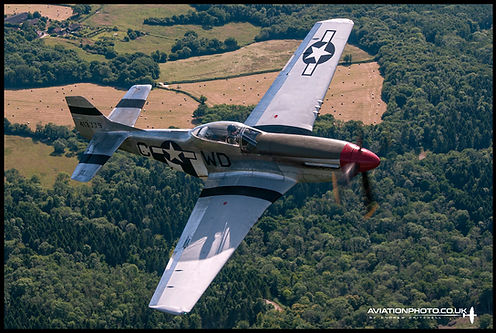

Then and now... separated by eight decades. On the left Alistair 'Steg' Williams pilots P-51D G-CMDK out of Biggin Hill while on the right Colonel Don Blakeslee pilots P-51D 44-13779 over UK skies in 1944.
At the time of his grounding, Blakeslee likely had over 1,200 combat hours under his belt, more than any other US fighter pilot in the Second World War (the standard combat tour in late 1944 was 300 hours). He had led the 4th since January 1944 and his leadership forged the path that would lead the group to becoming the top scoring outfit in the whole USAAF in World War Two claiming 583 aerial victories and a further 468 destroyed on the ground. Leading by example and teamwork and modest at his own successes, Blakeslee never displayed any personal decorations or kill tallies on his aircraft. The only dispensation to personalisation was the use of the code ‘C’ for his planes which he said stood for ‘Chief cook and bottle washer.’
Blakeslee stayed in the Air Force after the end of World War Two, going on to lead the Republic F-84 equipped 27th FG during the Korean War, before retiring with the rank of Colonel in 1965. He was highly decorated, having received two Distinguished Service Crosses, seven Distinguished Flying Crosses, two Silver Stars, six Air Medals and the DFC from World War Two and the US Legion of Merit and five other decorations from Korea. Blakeslee then lived a life out of the limelight in Florida with his long time wife and partner Leola Fryer, whose name had been on the side of his No 401 Squadron Spitfire. Blakeslee passed away on 3 September 2008, just a few days short of his 91st birthday.


Colonel Don Blakeslee and his P-51D Mustang WD-C
Steg and the Mustang

Flying the Mustang for the photo shoot was Alistair 'Steg' Williams. Williams’ background is Army Air Corps and, as well as flying and instructing on the Lynx, he also led the Blue Eagles display team before joining Rolls Royce and leading the Heritage Flight which was when this interview was conducted. More recently, Steg has been flying for Warbird Experiences Ltd at Biggin Hill. His passion for the Mustang is clear. When asked the inevitable question about what the aircraft is like to fly, Williams responded; ‘It's a funny question and it's a funny thing to answer. I think you'll get a different response from different people. For me, the absolute overriding emotion is one of privilege and I just feel remarkably fortunate to be able to do it and whilst I'd be gutted if I couldn't do it again it's one of those things I will take with me for the rest of my life that I've been able to do.’

‘In terms of actually flying the airplane, it's certainly exhilarating. I guess when you're physically off the ground it behaves like most of the aeroplanes of its type. It's fairly conventional. It does have its vices. Certainly at slow speed it stalls pretty aggressively. It's pretty heavy in pitch and roll, more so in roll, and so displaying it you tend to have both hands on the stick. It aerobats really nicely in the sort of standard manoeuvres, so that part of it is an absolute joy. It's pretty quick and on my first flight that was the thing that really struck me. It's fast and it's pretty heavy as well compared to some of the others, certainly the Spitfire.’

‘I think, because of my background, whilst I love the Spitfire for what it is, I probably don't have as strong an affinity to it as my RAF colleagues. I think one of the things I love about the Mustang is partly because of my size. I fit in it more comfortably whereas I feel quite claustrophobic in the Spitfire. Also, certainly in this country, the aeroplane is a little bit different, and that's a real attraction to me and, whilst I have been encouraged to fly our MkXIX, I actually would be very happy to stay exactly where I am until someone shoehorns me out of it! I would love to fly a Corsair, P-47 or a Mosquito. Those are probably the only things I would get out of the Mustang for. I would get out pretty quickly for a Corsair but then I'd probably want to go back to the Mustang! There's also a first love thing as well and I haven't mastered it yet. I don't think I ever will master it, but I'm a long way off being an expert. I'm clearly good enough, but before I moved on I would like to get to the point where I could say I strap it to me rather than strapping in. It's a really big thing for a pilot so I'm looking forward to that day.’
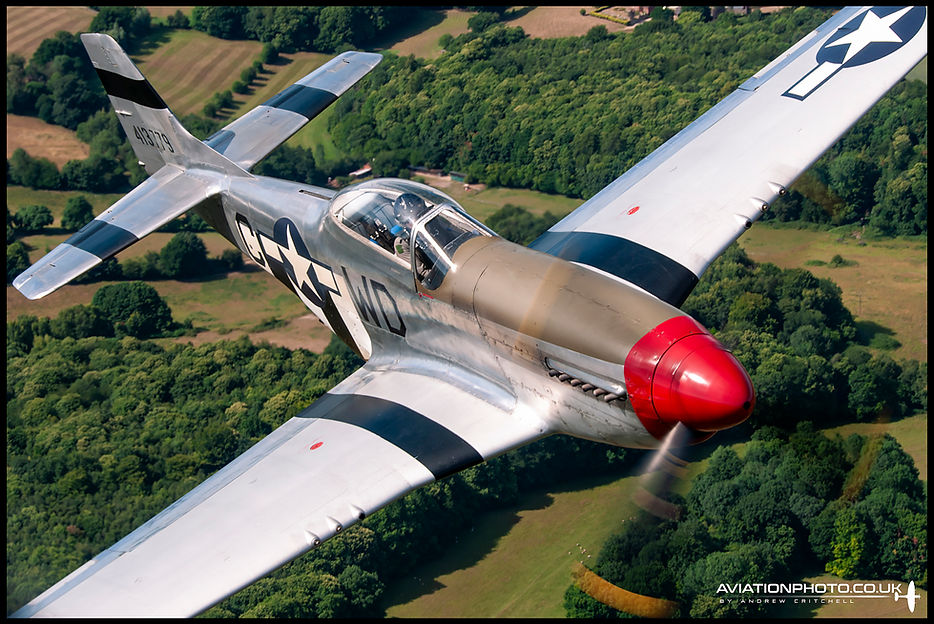
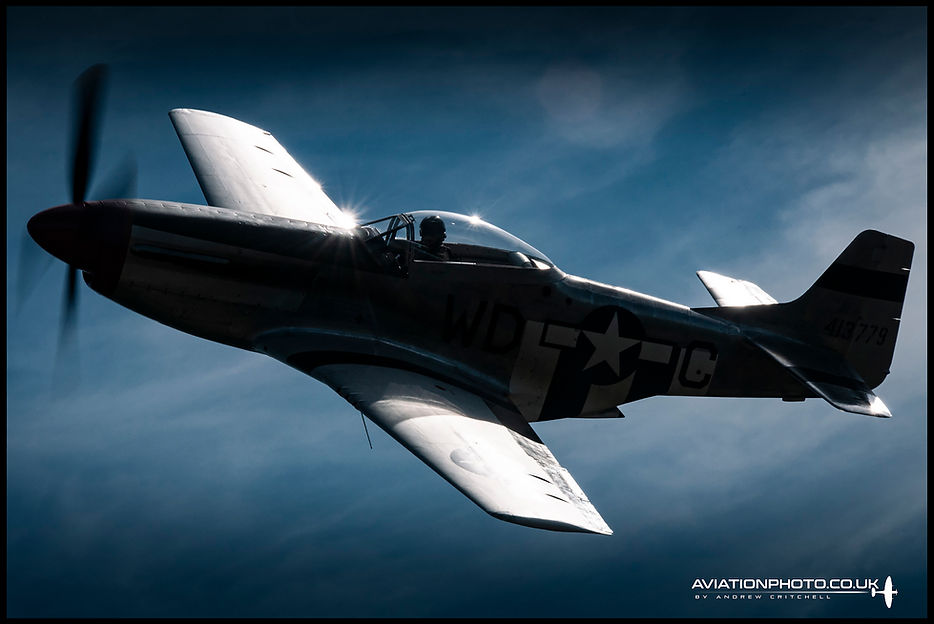
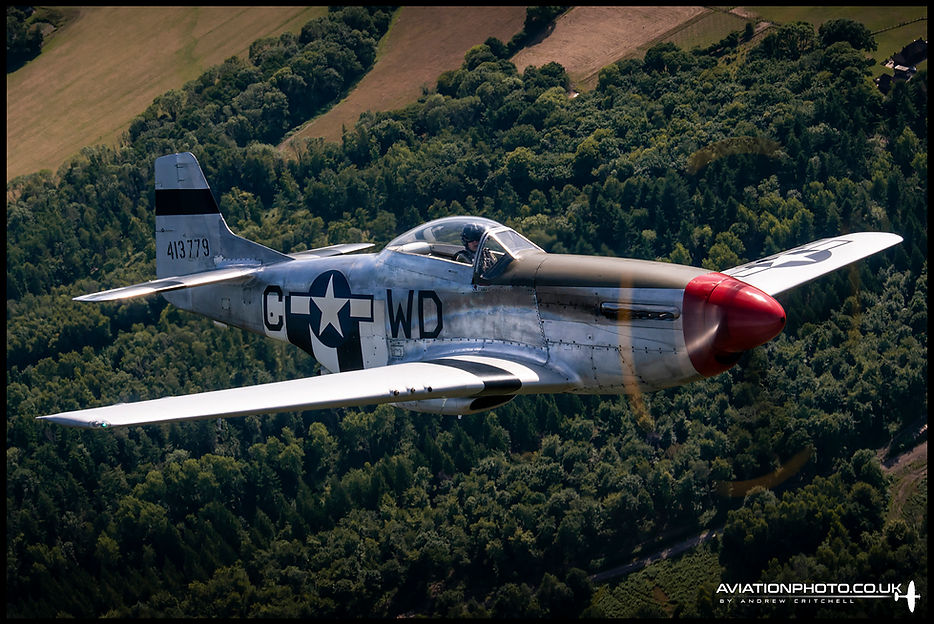
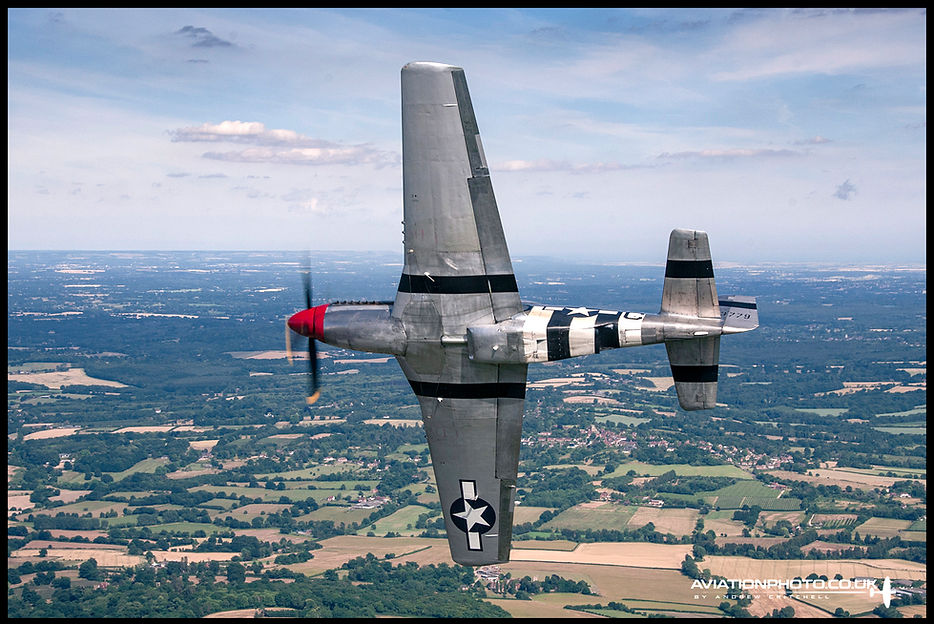



A month or so after the shoot, Aviationphoto travelled to the Rolls Royce Heritage Flight based at East Midlands Airport to get a closer look at G-CMDK,


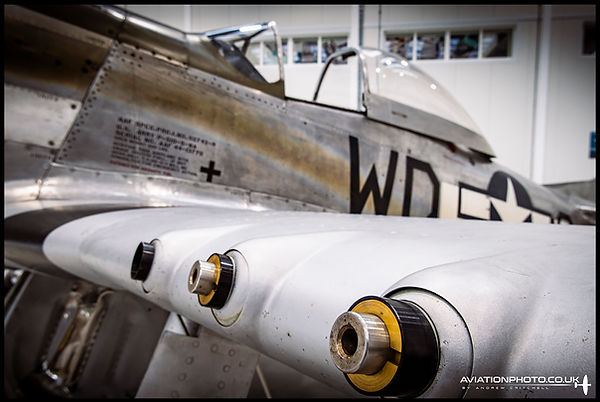
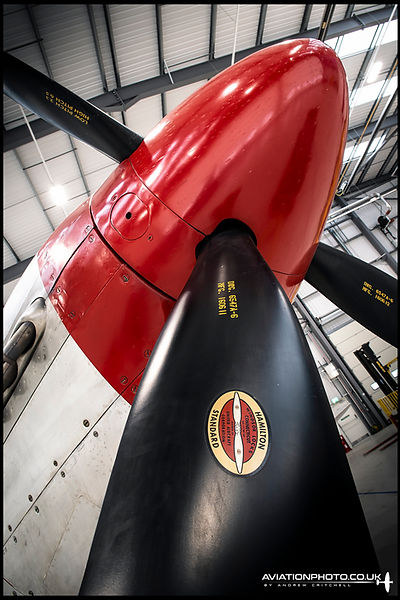
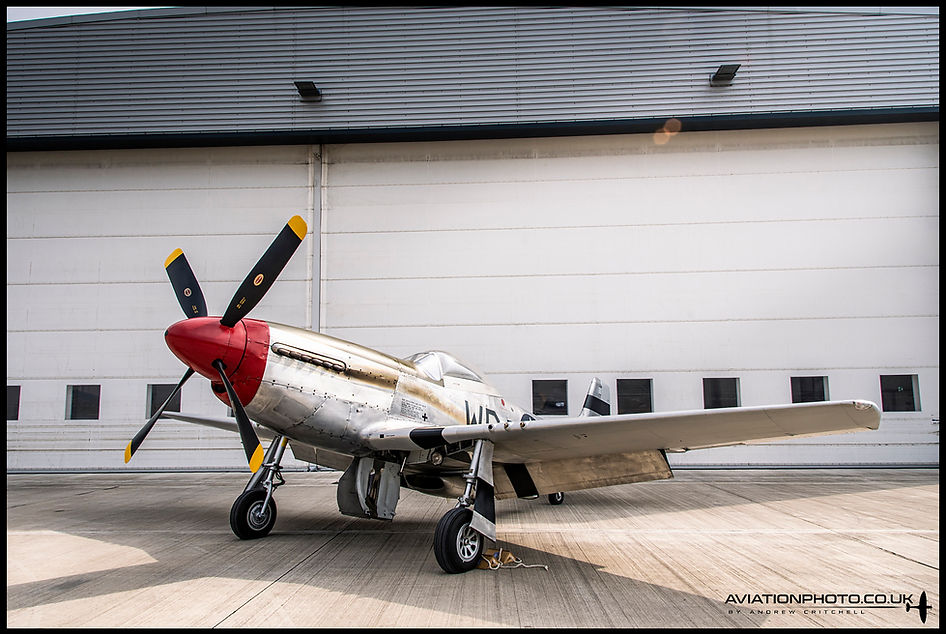


This article originally appeared in the April 2023 issue of Aeroplane Magazine